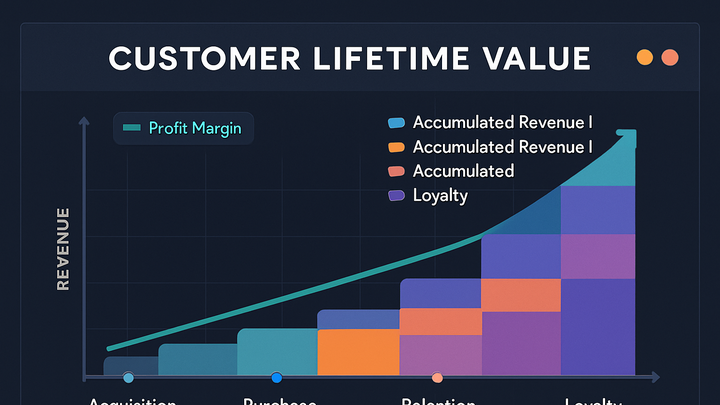Published on 2025-06-28T04:31:35Z
What is Customer Lifetime Value (CLV)? Examples of CLV
Customer Lifetime Value (CLV) is a predictive metric used in analytics to estimate the total net profit a business can expect from a customer over the entire duration of their relationship. It helps organizations understand which customer segments are most valuable and how much can be invested in acquisition and retention. CLV calculations can be based on historical data or predictive models that incorporate average revenue per user (ARPU), churn rate, and gross margin. By integrating CLV tracking into tools like Google Analytics 4 (GA4) or cookie-free solutions like PlainSignal, businesses can automate the monitoring of customer value and drive data-driven marketing strategies. Accurate CLV insights enable companies to forecast revenue, optimize marketing spend, and build long-term customer loyalty.
Customer lifetime value
Estimates the total net profit from a customer over their entire relationship.
Why Customer Lifetime Value Matters
Understanding CLV empowers businesses to focus on the most profitable customers and make strategic investments in acquisition and retention.
-
Informed marketing spend
By knowing how much a customer is worth, you can set acquisition budgets and bid strategies that drive positive ROI.
-
Revenue forecasting
CLV provides insights into future revenue streams by aggregating the expected value of all customers over time.
-
Customer segmentation
Segment customers by lifetime value to tailor retention and upsell strategies for high-value groups.
Calculating CLV
CLV can be calculated via several models, from simple historical sums to predictive formulas that factor in churn and discount rates.
-
Historical clv
Sum of past gross profit from a customer over a defined period. Useful for mature businesses with stable transaction histories.
-
Data needs
Requires accurate records of customer purchases and associated profit margins.
-
-
Predictive clv
Formula-based approach estimating future value. A common model is:
CLV = ARPU × (1 / Churn Rate) × Gross Margin-
Arpu
Average Revenue Per User over a specific period.
-
Churn rate
Percentage of customers who stop using your service during a period.
-
Gross margin
Revenue minus cost of goods sold, expressed as a percentage.
-
Implementing CLV Tracking with Analytics Tools
Leverage platforms like GA4 and PlainSignal to capture revenue events and compute CLV automatically.
-
Google analytics 4 (GA4)
- Define purchase events with a
valueparameter. - Ensure each user has a consistent ID to stitch sessions.
- Export to BigQuery and apply CLV formulas in SQL.
- Visualize results in Data Studio or Looker.
- Define purchase events with a
-
PlainSignal integration
Inject the PlainSignal script to enable cookie-free revenue tracking. Example:
<link rel="preconnect" href="//eu.plainsignal.com/" crossorigin /> <script defer data-do="yourwebsitedomain.com" data-id="0GQV1xmtzQQ" data-api="//eu.plainsignal.com" src="//cdn.plainsignal.com/plainsignal-min.js"></script>Then fire purchase events:
signal('event','purchase', { value: 100 });-
Event tracking
Implement revenue events with
signal('event','purchase', { value: amount })to feed CLV dashboards in PlainSignal.
-
Best Practices for Maximizing CLV
Improving CLV involves enhancing customer experience, reducing churn, and increasing average spend through targeted strategies.
-
Enhance retention strategies
Deploy loyalty programs, personalized email campaigns, and timely support to keep customers engaged.
-
Upselling and cross-selling
Recommend relevant products or upgrades based on purchase history to boost ARPU.
-
Personalized customer journeys
Use CLV segments to deliver tailored experiences that increase satisfaction and spending.
